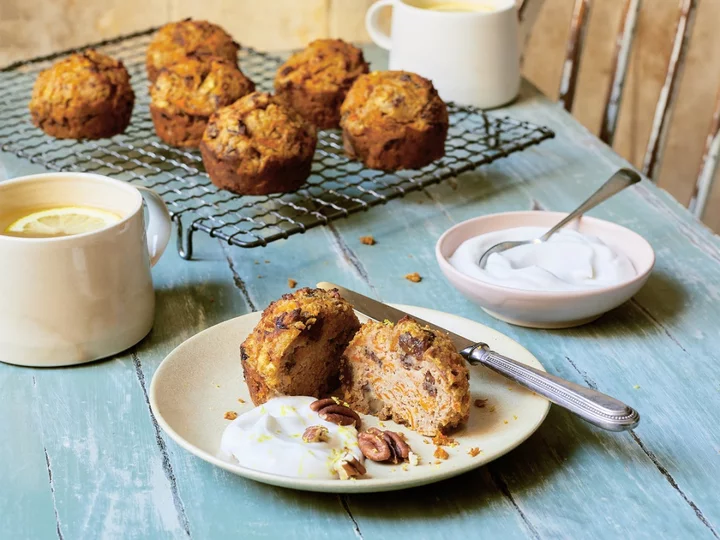
How to make healthy carrot and apple muffins
These muffins are naturally sweetened by the grated carrot, apple and cinnamon,” says functional nutritionist Pauline Cox. “This fibre fest will keep you feeling full and satisfied without a blood-sugar spike.” Carrot and apple muffins Makes: 12 Ingredients: 90g coconut oil, melted, plus extra for greasing 5 eggs 375g ground almonds 150g sultanas 90g walnuts or pecans, roughly chopped, plus a few extra to serve 3 tsp baking powder 3 tsp ground cinnamon 1 tsp salt 375g carrots, grated 375g apples, grated (green apples for a lower carb content) Zest and juice of 1 unwaxed lemon Coconut or natural yoghurt, to serve Method: 1. Preheat the oven to 170C fan and grease a 12-hole muffin tin. 2. In a mixing bowl, beat the eggs and combine with the melted coconut oil. 3. Add the ground almonds, sultanas, walnuts or pecans, baking powder, cinnamon and salt to the liquid egg mix, along with the grated carrots and apples and mix together to form a thick batter. Add in a quarter of the lemon juice (use the rest in drinking water) and half of the lemon zest. 4. Spoon the thick mixture into your greased muffin tray. Bake for 22-25 minutes. Remove from the oven and leave to cool. 5. Serve with a dollop of coconut or natural yoghurt, a pecan or a walnut and sprinkle with the remaining lemon zest. ‘Hungry Woman’ by Pauline Cox (Ebury Press, £27).
2023-07-05 19:22

The shared symptoms of menopause and young onset dementia
Dementia UK and The Menopause Charity have published advice on the crossover symptoms of both young onset dementia and menopause, after former TV presenter Fiona Phillips disclosed her Alzheimer’s diagnosis. The shared symptoms mean that it is difficult for some women to spot the signs of dementia and Alzheimer’s, and instead mistake those symptoms for menopause. It comes as Phillips has revealed that she has been diagnosed with Alzheimer’s, the most common type of dementia, at the age of 62. The former breakfast TV presenter first noticed symptoms of “crippling anxiety” and “brain fog”, but since Phillips had not experienced this before, she and her family thought it might be menopausal symptoms. After undergoing Hormone Therapy Treatment (HRT) to alleviate her menopausal symptoms, Phillips’s brain fog remained. This prompted Phillips and her husband to seek further help, including months of cognitive tests before a lumbar puncture to assess spinal fluid revealed she had Alzheimer’s. Dementia is an umbrella term for a range of progressive conditions that affect the brain, while Alzheimer’s is a specific disease. Paul Edwards, Director of Clinical Services at Dementia UK, said in a statement that many people are unaware of the shared symptoms of the conditions. “For some women, dementia and Alzheimer’s symptoms may develop at the same time as the perimenopause or menopause which can bring additional challenges when it comes to seeking a diagnosis,” he explained. Dementia UK and The Menopause Charity have worked together to create an information leaflet on the similarities and differences between young onset dementia and menopause and perimenopause. While dementia is most common in people over the age of 65, an estimated 70,800 people in the UK are living with young onset dementia, where symptoms begin before 65. Common menopause symptoms include changes in periods, hot flashes, fatigue, mood changes, anxiety, stress, brain fog, vaginal dryness and more. Brain fog is a very common menopause symptom, and women often say that their brains feel like “cotton wool” while experiencing it. The symptom can make it difficult to recall words, complete multiple tasks or find themselves losing things. This can affect concentration, word-finding, memory and multitasking, impacting their emotions and overall well being day to day. Since these symptoms may also occur in dementia, some women become concerned that they are showing signs of young onset dementia. According to Dementia UK, though, brain fog is not typically the first symptom of dementia, so there are other initial signs to be aware of if you are concerned about dementia or Alzheimer’s. Early signs of dementia are more likely to be changes in vision and spatial awareness, language problems and changes in behaviour. It is typical that family members, friends and work colleagues may notice these changes first, often before the person themselves. Both Dementia UK and The Menopause Charity advise that because it is difficult to know what these symptoms are being caused by, it is important to see a GP to address any concerns. For more information, you can access an information leaflet produced by both charities here. If you would like to speak to a dementia specialist Admiral Nurse about young onset dementia and perimenopause or menopause, or any other aspect of dementia, can call our free Helpline on 0800 888 6678 or by emailing helpline@dementiauk.org. Read More Fiona Phillips, 62, reveals she has Alzheimer’s disease Fiona Phillips explains why she hid Alzheimer’s diagnosis from her children Woman exits plane after tirade about passenger who is ‘not real’: ‘Final Destination vibes’ Fiona Phillips Alzheimer’s diagnosis at 62: 7 ways to reduce your risk Fiona Phillips explains why she hid Alzheimer’s diagnosis from her children Fiona Phillips, 62, reveals she has Alzheimer’s disease
2023-07-05 18:50

Fiona Phillips Alzheimer’s diagnosis at 62: 7 ways to reduce your risk
TV presenter Fiona Phillips has revealed she has been diagnosed with Alzheimer’s disease at the age of 62. The presenter and Daily Mirror columnist said the disease has “ravaged” her family and she had long feared being given the diagnosis. According to the Mirror, Phillips was diagnosed more than a year ago and is undergoing trials for a new drug that could slow the effects of the disease. Phillips, who is an Alzheimer’s Society ambassador, told the Mirror: “This disease has ravaged my family and now it has come for me. “And all over the country there are people of all different ages whose lives are being affected by it – it’s heartbreaking. “I just hope I can help find a cure which might make things better for others in the future.” As well as her column in the national newspaper, Phillips anchored GMTV for more than a decade from 1997. She also competed in the BBC’s Strictly Come Dancing in 2005. She is married to Martin Frizell, editor of ITV’s flagship programme Good Morning Britain. Phillips told the Mirror that, despite fearing she would one day be diagnosed with Alzheimer’s, the news was still a “gut-punching, shuddering shock”. The presenter said she feels “more angry than anything else” due to the disease having already affected her family life. “My poor mum was crippled with it, then my dad, my grandparents, my uncle. It just keeps coming back for us,” she said. Though she previously kept the news private, Phillips said she has decided to share her story to help end the stigma around Alzheimer’s. “There is still an issue with this disease that the public thinks of old people, bending over a stick, talking to themselves,” she said. “But I’m still here, getting out and about, meeting friends for coffee, going for dinner with Martin and walking every day.” She is taking part in clinical trials at University College Hospital in London, which aim to revolutionise future treatment. Hilary Evans, chief executive of Alzheimer’s Research UK, said: “We’re sending our love and support to Fiona and her family following her announcement that she’s living with Alzheimer’s disease. “Fiona’s been a friend of Alzheimer’s Research UK for well over a decade, and her support has shone such a valuable spotlight on the importance of research in overcoming the diseases that cause dementia. “There are around 70,800 people with dementia in the UK who, like Fiona, are under 65 and we’re determined to find a cure to end the heartbreak it causes.” It is thought at least five in every 100 people with Alzheimer’s are under 65. Though this figure may be higher, as it can be more difficult to get an accurate diagnosis at a younger age. So, is there anything you can actually do to help prevent dementia? 1. Stop drinking fizzy drinks Drinking too much coke or lemonade could increase your chances of developing dementia. People who consume the highest amounts of ultra-processed foods, like fizzy drinks and chocolate, may have a higher risk of developing dementia than those who eat the lowest amounts, a study by Huiping Li, of Tianjin Medical University in China, published in the Neurology journal, has indicated. 2. Say no to UPFs Sadly, lots of our go-to ingredients like sausages, ketchup and baked beans are highly processed, making them a risk-factor if consumed too frequently. Li, the author of the study, said: “These foods may also contain food additives, or molecules from packaging or produced during heating, all of which have been shown in other studies to have negative effects on thinking and memory skills. “Our research not only found that ultra-processed foods are associated with an increased risk of dementia, it found replacing them with healthy options may decrease dementia risk.” 3. Reduce your treats Too much chocolate and things like biscuits aren’t good for you, because they are highly processed and sugary. In fact, according to the study, for every 10% increase in daily intake of ultra-processed foods, people had a 25% higher risk of dementia. So, even just having a few extra biscuits or chocolates at work each day can heighten your risk. 4. Keep moving We all know being slumped at a desk, staring at a screen all day, isn’t great for your health, but it turns out sedentary jobs actually increase your risk of getting dementia. Dr Sara Imarisio, head of strategic initiatives at Alzheimer’s Research UK, said: “Our brains are incredibly complex, responsible for our memory, as well as what we think, feel and do. “Keeping our brains healthy as we age can help stave off diseases like Alzheimer’s, which physically attack brain cells, tearing away at the very essence of who we are. “We know that being physically and socially active can help us feel happier, healthier and more positive in general. “Lifting weights and running marathons aren’t for everyone, but there are many ways that we can stay physically active in our lives.” Noting more research published in the Neurology Journal, by Huan Song of Sichuan University in China, Imarisio continued: “This self-reported study adds to evidence that finding something you can stick to, that keeps you physically and socially active, is likely to have the greatest benefit to your health, rather than the activity itself. “The researchers found that even people with a high genetic risk for Alzheimer’s, the most common cause of dementia, could benefit from keeping physically active.” 5. Make an effort to see family and friends Social interaction is a really important way to keep your brain sharp and reduce your risk of dementia. If you avoid it, you are risking your health. According to Song’s research, people who were highly engaged in activity patterns, including frequent exercise and daily visits of family and friends, had 35% and 15% lower risk respectively, compared with people who were the least engaged. 6. Do the chores According to the same study, carrying out household chores is associated with a 21% reduced risk of dementia. Perhaps just increasing your brain activity a little, even just by washing up or changing your sheets, can help keep your mind active. 7. Play an instrument According to several studies, musicians are 64% less likely to develop mild cognitive impairment or dementia. So, if you’ve ever fancied playing the piano, guitar or ukulele, now’s the time – it’s never too late to learn something new. Read More Charity boss speaks out over ‘traumatic’ encounter with royal aide Ukraine war’s heaviest fight rages in east - follow live 7 popular destinations that will soon be in London’s ULEZ Kate’s best Wimbledon looks, as she steps out in retro outfit for the tennis How tennis could be harming your body – and why it does you good
2023-07-05 18:26
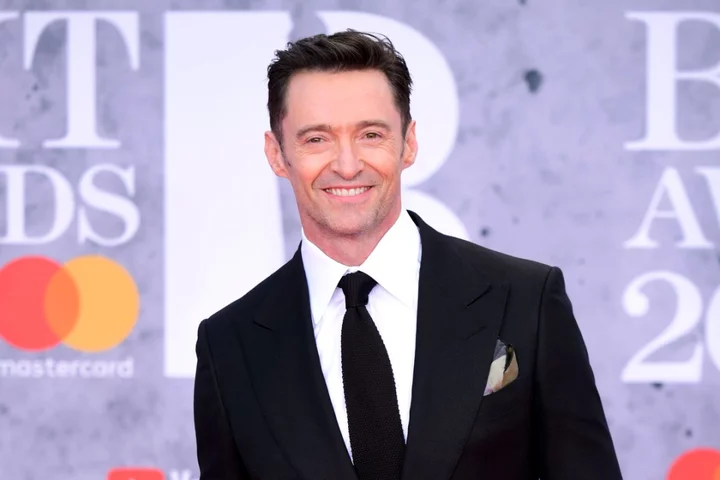
Hugh Jackman bemuses fans after sharing his ‘criminal’ cheat meal
Hugh Jackman has amused and confounded his followers after sharing a photo of his recent “cheat meal,” a plate of waffles topped with savoury mushrooms. Over the weekend, the Wolverine star took to Instagram to share photos of himself enjoying a meal at a waffle restaurant in England. The album began with an excited-looking Jackman holding up a fork, before including a photo of the menu at The Waffle House in Norwich. The post also included a photo of a plate of waffles topped with sauteed button mushrooms, and what appeared to be a red meat sauce and smoked ham cheddar cheese sauce. The dish was then garnished with herbs. The savoury waffles weren’t the only item ordered by the actor, however, as the post also included a photo of Jackman’s strawberry milkshake and one of his order of sweet waffles, which were topped with chocolate flakes, banana, peanut butter and powdered sugar. “Happy cheat meal to me! Nooo! I did not share. And I’m not sorry,” the actor captioned the photo album. However, in the comments, many of Jackman’s fans were confused by the first waffle combination, with some questioning the unique pairing. “MUSHROOMS ON WAFFLES? IS THIS THE WOLVERINE DIET?” one person jokingly asked, while another wrote: “Third pic is criminal.” “A cheat meal NEVER includes mushrooms,” someone else claimed, as another critic wrote: “Sweet waffle yes! Savoury, nooo!” Despite the concern from some of Jackman’s followers over the savoury-topped waffle, others said they’d happily indulge in the actor’s cheat meal. “OMG! I’ve never had a savoury-topped waffle but that looks delicious!! You deserve to enjoy all of your cheat meal so I’m glad you didn’t share,” one person commented, while another said: “Just give me those mushrooms and I’ll be in heaven.” The meal also prompted some to compare the savoury dish to chicken and waffles, with one viewer urging a critic to try the popular dish “with a side of mashed potatoes”. This is not the first time Jackman has shared insight into his unlikely “cheat meals,” as the actor previously told E! News that he enjoys “sort of weird simple stuff like lasagna”. “It’s sort of weird simple stuff like lasagna,” he said. “I like breakfast cereal at 11 at night, all that kind of easy simple stuff. In Australia, it’s meat pies.” Read More Fiona Phillips explains why she hid Alzheimer’s diagnosis from her children Woman exits plane after tirade about passenger who is ‘not real’: ‘Final Destination vibes’ The Witcher star says they’ve struggled to deal with Henry Cavill announcement Simple summer salads: Roquefort, rocket and pink grapefruit Joey Chestnut successfully defends title at Nathan’s annual hot dog eating contest How to make protein pancakes without flour
2023-07-05 17:26
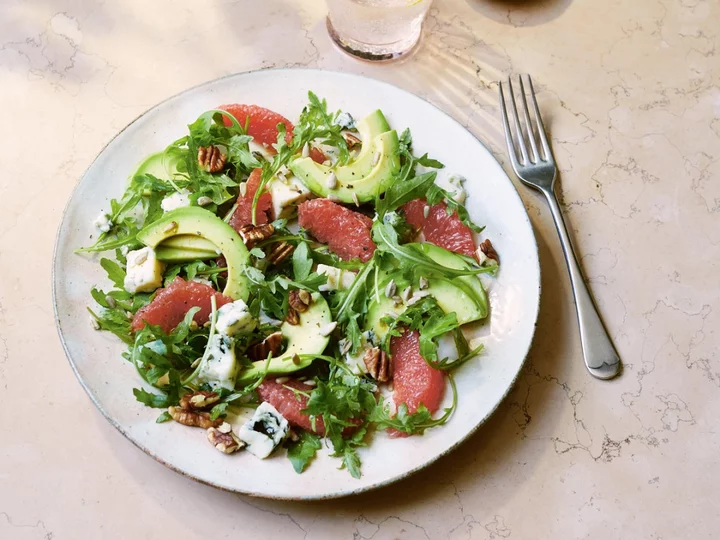
Simple summer salads: Roquefort, rocket and pink grapefruit
As colourful in nutrients as it is in appearance, this easy-to-construct salad is a powerhouse of goodness!” says functional nutritionist Pauline Cox. Roquefort, rocket and pink grapefruit salad Makes: one salad Ingredients: 90g rocket 100g Roquefort (ideally raw), cut into chunks 1 ripe avocado, peeled, stoned and sliced 2 pink grapefruits, segmented A drizzle of raspberry blush vinaigrette A handful of chopped fresh coriander A handful of pecans, chopped A handful of sunflower seeds For the vinaigrette: 100g raspberries (10-12 juicy raspberries) 60ml extra virgin olive oil Juice of 1 lime 20ml balsamic vinegar 20ml beet kvass (optional, but ideal) 1 tsp salt (ideally beetroot salt) Method: 1. To make the vinaigrette, add all of the ingredients to a blender and combine. Transfer to a clean glass jar with a lid, keep in the fridge and use within three days. 2. Lay the rocket leaves onto two plates, adding chunks of Roquefort, slices of avocado and pink grapefruit segments, and drizzle over the raspberry blush vinaigrette. 3. Sprinkle over the chopped coriander, pecans and sunflower seeds. ‘Hungry Woman’ by Pauline Cox (Ebury Press, £27). Read More Ditch Deliveroo – make these healthy, 30-minute pizzas instead Three quick and easy vegan fakeaway recipes The dish that defines me: Eddie Huang’s Taiwanese beef noodle soup Nutritionist explains how women can eat to help balance hormones How to make protein pancakes without flour The only three recipes you need to seize the summer
2023-07-05 17:23
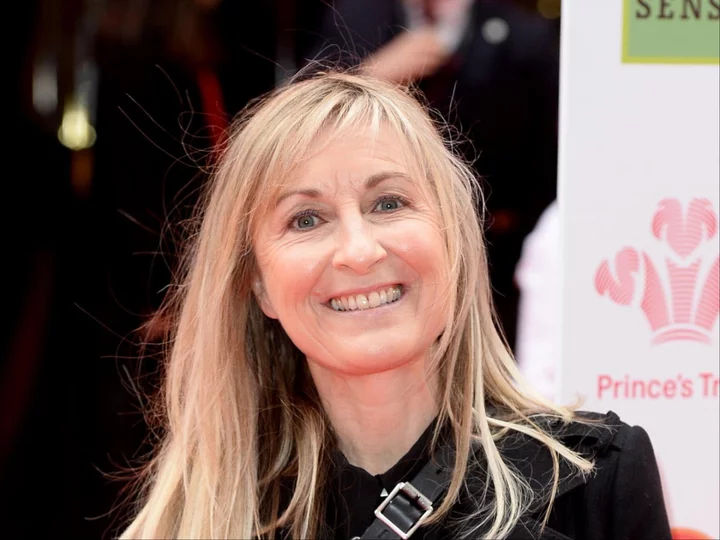
Fiona Phillips explains why she hid Alzheimer’s diagnosis from her children
Fiona Phillips has explained why she temporarily hid her Alzheimer’s diagnosis from her two sons. The former breakfast TV presenter, 62, was told she had the condition 18 months ago after she experienced symptoms of anxiety and brain fog, and has since disclosed her diagnosis to the public. Phillips, who is currently taking part in a drug trial that scientists hope could revolutionise the treatment of the incurable illness, said she was speaking out about her diagnosis in a bid to end the stigma surrounding Alzheimer’s. The journalist, best known for presenting the ITV Breakfast programme GMTV Today, toldThe Mirror that she was reluctant to tell her two sons, Nat, 24, and Mackenzie, 21 – who she shares with her husband, This Morning boss Martin Frizell – about her condition. “I just didn’t want to make a big thing out of it where we all sit down as a family and announce we’ve got something to tell them,” she said, “And I was worried they might be embarrassed in front of their friends or treat me in a different way. And it’s not like I’m doing anything out of character.” Phillips, who took part in BBC’s Strictly Come Dancing in 2005, shared that she and Frizell had blood tests to check whether their children could inherit the disease. “We wanted to know in case we needed to prepare the boys to make some difficult decisions later in life”, Frizell told the publication. “When the results came back as negative it was a huge moment – such an enormous sense of relief. There’s no Alzheimer’s on my side of the family and thank goodness it seems the boys have not inherited from Fiona’s side of the family.” The mother-of-two has now spoken out about the realities of the condition. “There is still an issue with this disease that the public thinks of old people, bending over a stick, talking to themselves,” Phillips said. The presenter said that she is no longer allowed to drive but walks each day: “I’m still here, getting out and about, meeting friends for coffee, going for dinner with [my husband] and walking every day.” The news comes as the Office for National Statistics said that dementia and Alzheimer’s disease were the leading cause of death in the UK in 2022. The couple began to notice something was wrong when she developed “crippling anxiety” towards the end of 2021. Since Phillips had not experienced this before, they thought it might be menopausal symptoms. “We got in touch with a menopause specialist who took her under their wing and put her on HRT but while that improved some symptoms, the brain fog remained,” Frizell said. This prompted the couple to seek further help, including months of cognitive tests before a lumbar puncture to assess spinal fluid revealed she had Alzheimer’s. Phillips is taking a new drug called Miridesap, which scientists hope could slow or even reverse the illness. The drug is administered three times a day with tiny needles and is being trialled by the University College Hospital (UCH) in London. Phillips has no idea if she is among the cohort reviewing a placebo or not but still believes that partaking in the trail is important for eventually finding a cure for the disease. “Even the people we see for the check ups don’t know if Fiona is on the real drug or a placebo,” Frizell said. “It’s been weeks now and I like to think her condition is stabilising but I am too close to know really, that could just be my wishful thinking.” Read More Fiona Phillips, 62, reveals she has Alzheimer’s disease Woman exits plane after tirade about passenger who is ‘not real’: ‘Final Destination vibes’ Jay-Z’s mother Gloria Carter ‘marries longtime partner Roxanne Wilshire’ Fiona Phillips, 62, reveals she has Alzheimer’s disease This is how Novak Djokovic is preparing to win Wimbledon How tennis could be harming your body – and why it does you good
2023-07-05 15:57
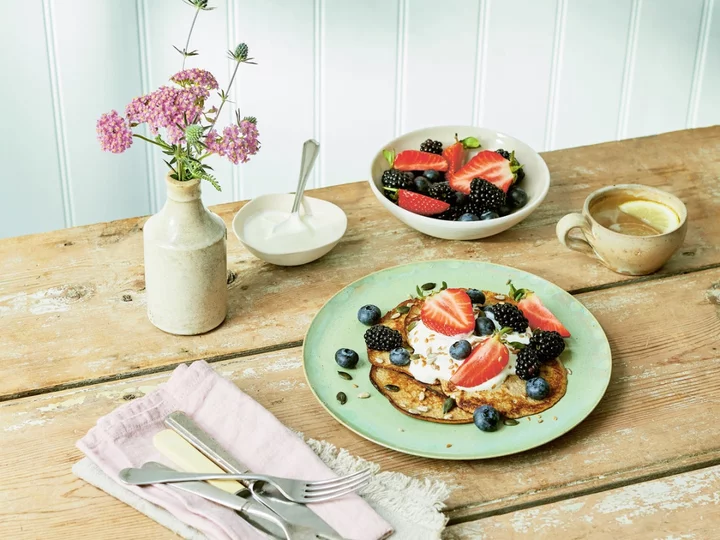
How to make protein pancakes without flour
These protein-packed, flourless pancakes can be made without the collagen, but the extra hit of amino acids in the morning is ideal for muscle-building and hunger control,” says functional nutritionist Pauline Cox. “When bananas are green, they have less sugar content… you decide how green you want to go. Delicious hot or cold!” Green banana pancakes Makes: 12 Ingredients: 1 greenish banana 2 eggs 1 tbsp collagen peptides (optional) ½ tsp ground cinnamon Coconut oil or ghee, for frying Natural yoghurt, fresh berries, chopped nuts and seeds, to serve Method: 1. Add the banana to a blender with the eggs, collagen (if using) and cinnamon, then combine to create a smooth batter. 2. Heat a small amount of coconut oil or ghee in a frying pan, and when the pan is hot, add 3-4 spoons of batter to create 3-4 mini pancakes. Cook for 2-4 minutes until golden in colour before flipping over to cook on the other side. 3. Serve with natural yoghurt, fresh berries, chopped nuts and seeds for extra goodness. ‘Hungry Woman’ by Pauline Cox (Ebury Press, £27). Read More Ditch Deliveroo – make these healthy, 30-minute pizzas instead Three quick and easy vegan fakeaway recipes The dish that defines me: Eddie Huang’s Taiwanese beef noodle soup Nutritionist explains how women can eat to help balance hormones The only three recipes you need to seize the summer How to shop at Borough Market in the summer
2023-07-05 13:46

Jennifer Lopez clarifies that she does drink 'responsibly' as the owner of a new cocktail brand
Jennifer Lopez is setting the record straight on her relationship with alcohol as the owner of her own recently launched cocktail brand, after having been previously known to not imbibe.
2023-07-05 02:26

Hugh Jackman divides fans with savoury ‘cheat meal’ of waffles and mushrooms
Hugh Jackman has amused and confounded his followers after sharing a photo of his recent “cheat meal,” a plate of waffles topped with savoury mushrooms. Over the weekend, the Wolverine star took to Instagram to share photos of himself enjoying a meal at a waffle restaurant in England. The album began with an excited-looking Jackman holding up a fork, before including a photo of the menu at The Waffle House in Norwich. The post also included a photo of a plate of waffles topped with sauteed button mushrooms, and what appeared to be a red meat sauce and smoked ham cheddar cheese sauce. The dish was then garnished with herbs. The savoury waffles weren’t the only item ordered by the actor, however, as the post also included a photo of Jackman’s strawberry milkshake and one of his order of sweet waffles, which were topped with chocolate flakes, banana, peanut butter and powdered sugar. “Happy cheat meal to me! Nooo! I did not share. And I’m not sorry,” the actor captioned the photo album. However, in the comments, many of Jackman’s fans were confused by the first waffle combination, with some questioning the unique pairing. “MUSHROOMS ON WAFFLES? IS THIS THE WOLVERINE DIET?” one person jokingly asked, while another wrote: “Third pic is criminal.” “A cheat meal NEVER includes mushrooms,” someone else claimed, as another critic wrote: “Sweet waffle yes! Savoury, nooo!” Despite the concern from some of Jackman’s followers over the savoury-topped waffle, others said they’d happily indulge in the actor’s cheat meal. “OMG! I’ve never had a savoury-topped waffle but that looks delicious!! You deserve to enjoy all of your cheat meal so I’m glad you didn’t share,” one person commented, while another said: “Just give me those mushrooms and I’ll be in heaven.” The meal also prompted some to compare the savoury dish to chicken and waffles, with one viewer urging a critic to try the popular dish “with a side of mashed potatoes”. This is not the first time Jackman has shared insight into his unlikely “cheat meals,” as the actor previously told E! News that he enjoys “sort of weird simple stuff like lasagna”. “It’s sort of weird simple stuff like lasagna,” he said. “I like breakfast cereal at 11 at night, all that kind of easy simple stuff. In Australia, it’s meat pies.” Read More Hugh Jackman reveals he tested negative for skin cancer after undergoing two biopsies Child, 8, raises more than $37,000 to help his favourite Waffle House employee get a car Ditch Deliveroo – make these healthy, 30-minute pizzas instead The dish that defines me: Eddie Huang’s Taiwanese beef noodle soup Nutritionist explains how women can eat to help balance hormones
2023-07-05 00:57
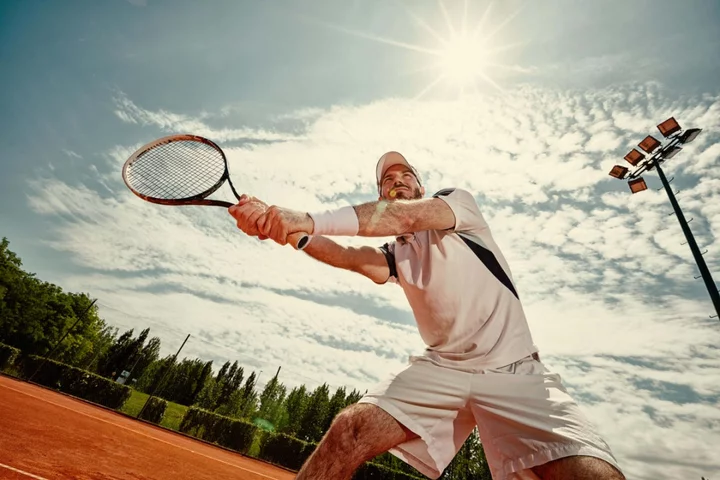
How tennis could be harming your body – and why it does you good
With Wimbledon underway and Nick Kyrgios already out due to injury, is tennis actually any good for you? Every tournament brings fresh injuries into the public eye, but the sport’s praises are often sung by fitness fans all over the world. So, how does it weigh up health and safety-wise? Is it worth investing some time in the sport if you enjoy Wimbledon? Tennis elbow The most common injury in tennis is tennis elbow, says Lucy Macdonald, physiotherapist at Octopus Clinic, and it’s something which has affected the likes of Andy Murray and Venus Williams. “Tennis elbow is the generic term for pain in the elbow, normally where irritation of the tendon runs over the elbow.,” she says. “It is often caused by a sudden overload on a tendon, in a way it is not used to, and it cannot cope with the forces that are on it. Treating it involves modifying what you are doing. “It can also be caused by other racket sports, and even things like breastfeeding a baby or cutting hedges and gardening,” she explains. But, it isn’t the end of tennis dreams. You can treat it. “Do not completely rest, modify the load going through the elbow, reduce the frequency and longevity of playing tennis, but things like physical support and tape can also help. “Changing your technique to take pressure off the tendon can help,” Macdonald explains. “The long-term treatment is to gradually build up the resilience of the tendon – a top spin stroke adds the most pressure – and alongside that, use static contractions – exercises that are just contracting the muscle, holding it and then relaxing.” Wrist injuries Kyrgios has pulled out of Wimbledon already, due to a wrist injury. “People may get wrist injuries if they fall and fracture the wrist. Or if they get a repetitive strain injury – if you use your wrist a lot in terms of the strokes you use with a lot of topspin – you can get some overuse and cause a flare up,” says Macdonald. Ankles and knees “Being on a slippery court, it can be easy to go over on your ankle,” she continues. “It happens in a lot of sports, if you’re running for a ball or trying to change direction. “You might get some knee problems, as they take such a hit generally with any propulsive sport – you get wear and tear on the knees, and sudden twists could impact your medial meniscus. Strength training is the best thing for that.” The benefits Should you be worried about all these injuries if you want to start playing, though? “The main cause of injuries in tennis is the sporadic nature people play it. If they suddenly go and play once every few months, the body is not used to the movements required in tennis, ” Macdonald notes.“You may suddenly run across the court and strain your calf or rupture your Achilles, because you haven’t run in months. “If you play it regularly and are consistent with the amount you play, it can be really beneficial,” she says.Any exercise is good, but the social aspect of tennis is hugely motivating, if you’re meeting up with three friends to play tennis, you have to show up – it gets you exercising regularly if you do it consistently. Tennis is beneficial for “increasing your heart and breathing rate, which is really good for your cardio and respiratory system. It keeps the range of motion in your shoulders, improves your balance with direction changes, and reduces your risk of falling,” says Macdonald. So, don’t let the risk of injury put you off. “There are so many positives that outweigh the negatives. Exercise, in general, extends your life span, and every illness out there is reduced by doing exercise. Even though it may have some impact on our musculoskeletal system, it is overwhelmingly positive for your mental and physical health.”
2023-07-04 19:51
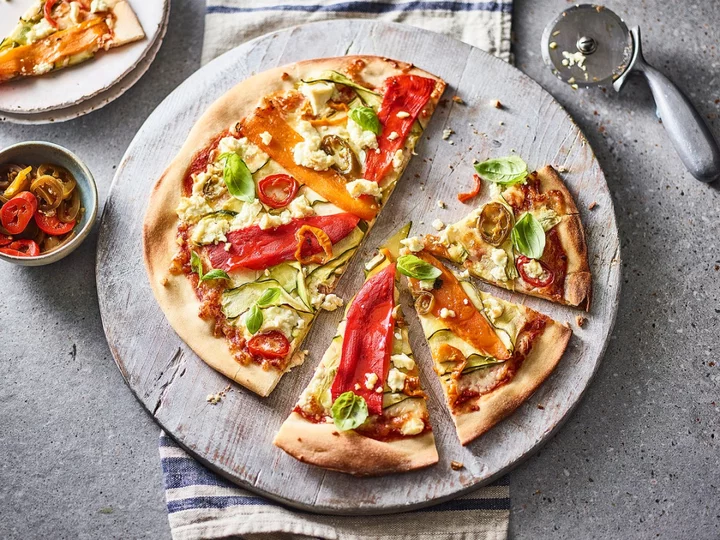
Ditch Deliveroo – make these healthy, 30-minute pizzas instead
Stop ordering pizzas on Uber Eats and get into the kitchen to make your own. These spicy feta, pepper and courgette pizzas from Cooks&Co will be hot and ready to eat long before a delivery driver gets there with your cold, soggy takeaway. Swap meat for vegetables and mozzarella for feta and you can call it a healthy win, too. Spicy feta, pepper and courgette pizzas Serves: 4 Prep time: 15 mins, plus defrosting | Cooking time: 12-15 mins Ingredients: 2 x 220g frozen pizza dough balls, defrosted 100g pizza sauce 200g grated mozzarella 1 courgette, cut into ribbons 150g Cooks&Co Roasted Red and Yellow Peppers, quartered 25g Cooks&Co Tri-colour Jalapeno Slices 100g feta To serve: Drizzle extra virgin olive oil Basil leaves Method: Preheat the oven to 240C/gas mark 9. On a floured surface, roll out each dough ball into a rough 30cm round and place on 2 large lightly floured baking trays. Spread with the pizza sauce leaving a 2cm border. Sprinkle with cheese and top with courgette ribbons, peppers and jalapenos. Crumble over the feta and drizzle with a little olive oil. Bake for 12-15 minutes. Drizzle with extra oil and scatter over a few basil leaves to serve. Cooks tip: Add spoonfuls of mascarpone instead of feta. For more recipes, visit cooksandco.co.uk Read More Three quick and easy vegan fakeaway recipes The dish that defines me: Eddie Huang’s Taiwanese beef noodle soup Nutritionist explains how women can eat to help balance hormones The only three recipes you need to seize the summer How to shop at Borough Market in the summer Budget Bites: Three light recipes that sing of summer
2023-07-04 18:23

This is how Novak Djokovic is preparing to win Wimbledon
Tennis won Novak Djokovic over when he was just four years old. Since then, the Serbian professional tennis player established himself as a reigning men’s champion. In July 2006, he won his first Association of Tennis Professionals (ATP) event, and reached the semi-finals at Wimbledon and the French Open a year later. The 36-year-old also advanced to the finals of the US Open in 2007, but lost in straight sets to the former Swiss professional tennis player Roger Federer. He managed to win his first Grand Slam tournament at the Australian Open and was awarded a bronze medal at the 2008 Beijing Olympics. Though Djokovic’s performance has plateaued at some points, his hot streak has continued over the last 16 years. He claimed his 21st Grand Slam championship after winning Wimbledon in 2022 and gained his 10th title at the Australian Open, crowning both him and Rafael Nadal with the most Grand Slam men’s singles championships. With the 2023 Wimbledon Championships in full swing until July 16, how will Djokovic prepare himself both mentally and physically to win? Diet Djokovic starts his day with raw celery juice — which has anti-inflammatory properties – and sometimes drinks it before, during and after matches. Celery is about 90% water, so it’s great for hydration first thing in the day, especially when you don’t feel like chugging down a glass of water. On other occasions, he drinks the green goddess smoothie, “which is a load of green things chucked in and blended. In the food industry, you can get green goddess dressings, sauces and juices, which all have kale, spinach, peas, mint, cucumber, apple and spirulina powder all blended into one”, says celebrity private chef Ethan Russell. And for breakfast, Djokovic would normally eat a power bowl — it’s got a lot of healthy fats, grains, and fruit in it — or have it as a snack before exercising. The clear number one rule is being gluten and dairy-free. “It’s a choice many athletes make, especially if they want to feel and perform their best. Gluten and dairy can cause irritation,” Russell says. There are so many different dairy and protein alternatives at the moment, such as coconut, soy and almond. “The bowl has different types of grains, gluten-free granola — with pumpkin seeds and goji berries — then a low sugar style muesli,” he adds.“If you are an athlete and trying to keep your sugar low, you can opt for dairy-free yoghurt and manuka honey, which is quite expensive and very sought after, with its anti-inflammatory properties. People use it in food and skincare, making it a super food. The bowl is then topped with blueberries and strawberries, packed with natural sugars.” Warming-up Djokovic would usually start warming-up with his physiotherapist, then move onto to mobilisation and movement exercises, to minimise the risk of major injuries. Warm-ups can be anything from the running man, squat reaches to the sky and lunge rotations, all of which encourage great blood circulation. A match can last one and a half hours, and there are so many things to manage on match days, according to Mark Taylor, who coaches British tennis player Ryan Peniston and also works at the Junior Tennis Coaching academy. “They play all year round and often under immense pressure. It’s why I also work with a sports psychologist,” he says. Mindfulness Djokovic is heavily into mindfulness, and might begin his day with silent meditating — especially if he’s got an important game to focus on — in a grounded way, to promote mental clarity, calm focus and energy. “Most of us find it difficult to sit still,” says Loren Peta, yoga teacher and personal trainer. “But gentle movement and box breathing — where you draw a box with your mind’s eye to help you stay present — is a great way to transition from a state of doing to state of being.” Whilst in conversation with former Spanish tennis player Alex Corretja at the The House of ASCIS event last Friday, Djokovic opened up about his mental health and wellbeing. “If we are talking about mental strength and preparation, and how it affects performance, I feel like half of the work is already done before you step out on to the court – also known as the battlefield,” Djokovic said. “It’s why I try to only peak at the biggest tournaments and take more time than I used to, to get my mind and body into perfect harmony. My body is responding differently than it was 10 years ago, so I have to be more specific with my preparation, work, training and recovery. I believe in a holistic approach to this sport, and everything else in life. “It’s about everything you do, eat, the relationships around you, how you perceive yourself, the traumas and emotions that are suppressed in you. I know for me, if I suppress something, it will always surface on the court. The more you put these things aside, the bigger the monster will become. “If you fail to prepare, it’s going to be a difficult mountain to climb during the match. Tennis isn’t a sprint, it’s a marathon as well.” Getting the right footwear There are certain things that are important to keep in your kit. But for Djokovic, his racket and shoes are the two most important items for every tennis player, especially at his level. Good shoes adapt to the way a tennis player moves their feet, to ensure the right support and exact comfort can be added, if required. For example, improved extra heel cushioning and ankle support. “The details [are important],” said Djokovic. “Every single thing matters. How you move, how you feel with your racket and shoes. You need to be comfortable with what you are wearing, because it’s going to help you perform and move better. “I probably move differently to most of the guys out there – even on grass, I slide. [So I need] really flexible shoes that allow me to stop when I need to stop, and change directions when I need to change directions. It can’t be too light or too heavy.” Read More Charity boss speaks out over ‘traumatic’ encounter with royal aide Ukraine war’s heaviest fight rages in east - follow live Money-saving ways to garden on a budget 8 budget-friendly ways to juggle childcare and work during holidays Dior’s couture show was the epitome of quiet luxury
2023-07-04 16:48
